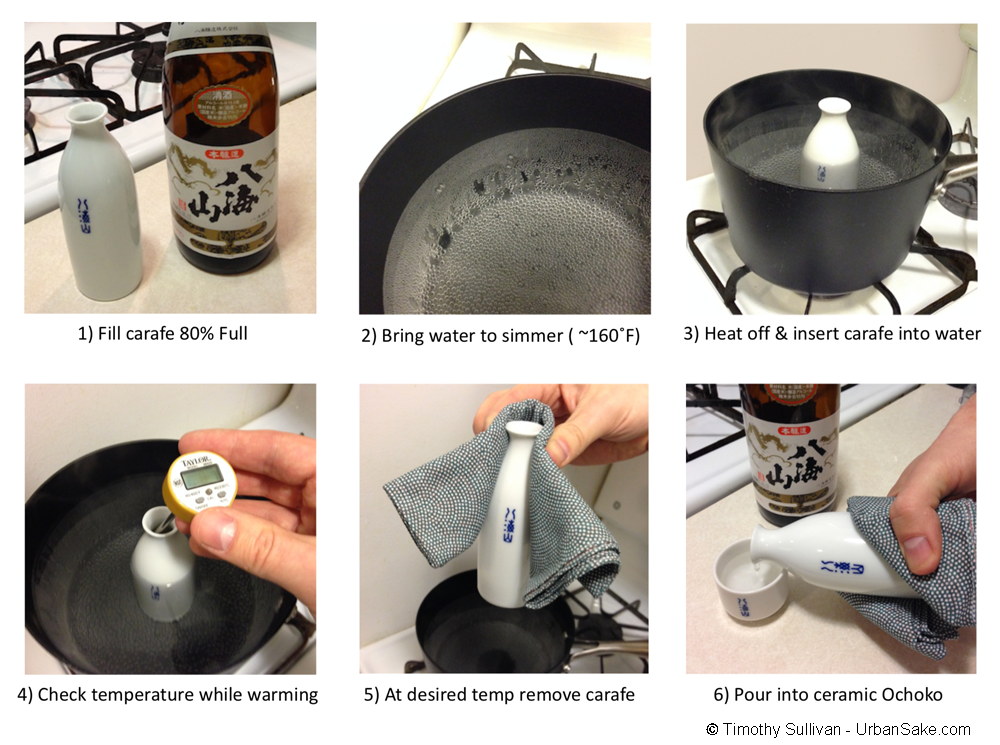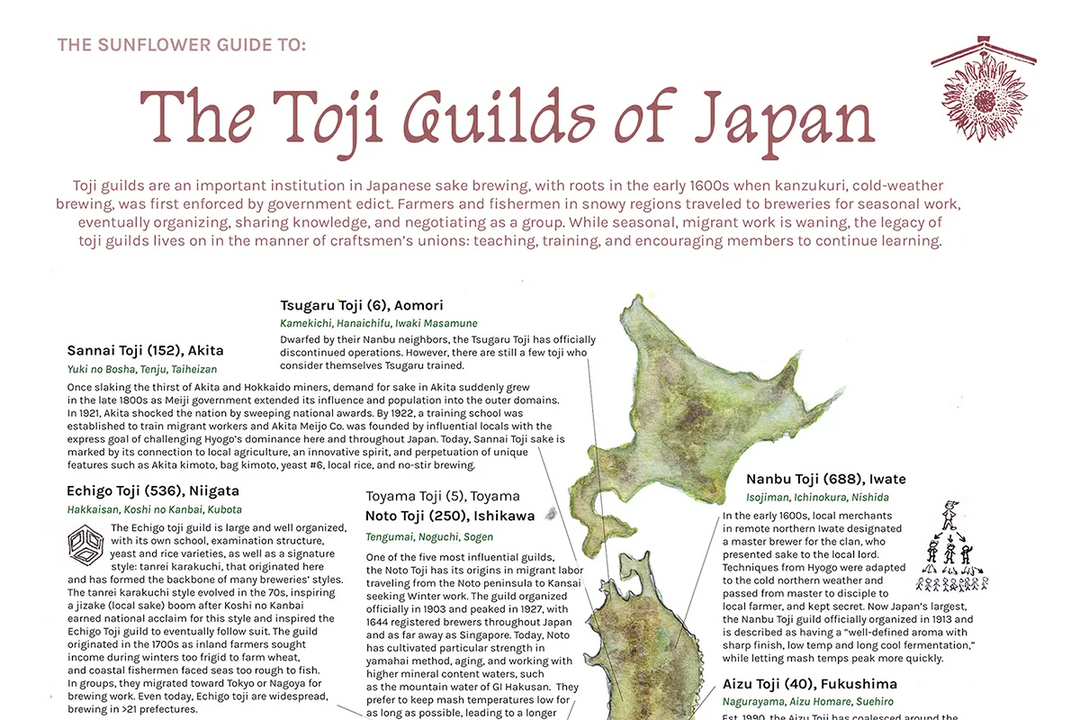Kanzake: dispelling the myths around hot sake


Introduction to Kanzake
One of the great and unique pleasures of sake is the dimension of temperature, which can be used like an equalizer in a sound system. At cool temperatures aromatics are muted (much like wine) and the overall impression on the palate is more refreshing and dry, with a lighter body and thinner texture. But at warm temperatures, aromas are emphasized and the perception of sweetness, body, umami and acidity is heightened. Hot temperatures have their own unique effect: besides conveying warmth to the drinker, the sake seems drier, sharper, and less aromatic. In the frigid temps of Fall and Winter, kanzake provides comfort, nourishment, and ambiance in a way that ice-cold daiginjo cannot.

It's a common misconception that sake is heated in order to cover up its flaws. While hot sake very often has flaws to cover, that's due to the poor quality of the sake being used: typically 18L bag-in-box Ozeki or Gekkeikan, the sake equivalent to Franzia or Coors Light. The Taiji heater on the left is a good example of this. Many liters of bulk sake are kept in the basin and pass through a heated coil before dispensing from the spigot. Your choices are: cold or hot?
In truth, alcohol has been enjoyed warm in Japan since the Jomon period (3rd century BCE), and kanzake specifically has been enjoyed by nobles for over a thousand years, widespread since early Edo (1600s-1800s). Old fashioned sake, that is sake from Edo era and prior, was more flavorful, funky and sweeter than it is today, having been polished a maximum of 12% and fermented with wild microbes. So the ancient experience of warming is very different from today's modern brews, which are comparatively dry, simple, and clean. My impression is that the more savory, flavorful, and funky the sake is, the more likely it will benefit from heating. For the same reason that you probably don't want to heat up your melon soda, I doubt you'd enjoy a warm junmai daiginjo. Studies have borne this out: subjects overwhelmingly prefer ginjo and daiginjo at cooler temperatures.
Method
Because tastes vary so widely, there's no substitute for home experimentation. While I prefer sweet, round nurukan (100-110F), you might prefer the sharp dryness of tobikirian (130-140F). The only way to know for sure is to experiment with a range of temperatures and brands.
All you need to heat sake at home is a thermometer ($5 at your local restaurant supply), a heat-resistant vessel such as a ceramic carafe or metal bain marie, a burner, and a pot of water. Heat the water to boiling, then take it off the heat. Immediately place the sake-filled carafe in the hot water. With the thermometer submerged in the carafe, keep an eye on the rising temperature. At each heat interval below, taste and record your impressions. Consider keeping an umami-rich snack handy (cheese, salami, sesame sticks) to experiment with pairings as well.


If you find you really enjoy kanzake and want to simplify the process, a Chinese company named Twinbird makes an excellent electric sake kettle that I use at home. I prefer this over the tealight warmers because it's more precise and will hold the sake at your chosen temperature. But if I'm feeling attached to a particular tokkuri one evening and I don't want the manufactured look of the Twinbird, I'll just use the above method with a pot of water.
Note that once sake is heated past ~110F, most brands change permanently, tasting slightly harsh or out of balance after cooling down. So only heat up a small amount at a time. If you have any excess sake after warming, save it for cooking.
Kanzake Temperatures
85F (30C): Hinata kan, like a sunny Spring day
The very start of notable changes in taste and aroma. Slightly enhanced aroma, sweetness, and body. Because it takes the same effort to achieve and delivers only a very slight change, I rarely use Hinatakan, instead preferring Hitohadakan (95F) and Nurukan (105F). However, I’ve recently been feeling that Harada 80 is in a particularly lovely place at Hinatakan, with the cherry pit and amaretto volatiles taking center stage.
95F (35C): Hitohada kan, body temperature
Compared to cooler temperatures the savory rice aromas will become more evident, as well as the flavor of the koji (chestnut-like sweetness). Structurally, the finish elongates and the body increases. Hitohada kan is recommended for:
- Savory styles of honjozo, such as Kenbishi Kuromatsu, Akitabare Shunsetsu Spring Snow (Fall-Winter, once it has aged in bottle a while), or Daishichi Honjozo, which gain body and enhanced savory aromatics.
- Everyday junmaishu with grain-driven flavors, although these styles are usually quite versatile and show well, albeit differently, in all temperatures. This is also the highest temperature I recommend for 18%+ genshu (undiluted) brews, although there are exceptions-- especially if you don’t mind a bit of alcohol vapor at warmer temps. Examples include Masumi Okuden Mirror of Truth, Ohyama Aka, or Suigei Drunken Whale.
- Savory-fruity junmai ginjo or tokubetsu junmai, when you want to emphasize savory characteristics and increase body. Two good examples of junmai ginjoshu that take well to hitohadakan include Kanbara Bride of the Fox and Chogetsu Clear Moon.
- Yamahai and kimoto styles if you’d prefer to keep the sensation of acidity down, while enhancing the texture and flavor.
105F (40C) Nuru kan, lukewarm
This is my favorite temperature for heating sake, as it enhances aroma, structural elements, sweetness, body and acidity, without 1) adding astringency/sharpness, and 2) making the alcohol vapors too strong. Sake can take on new textures: soft, slippery, velvety, and interact with food differently. It’s also just enough to feel warmed and comforted by the drink. In contrast, hitohadakan (95F) can feel tepid, lacking the ambient vibes you expect from warm sake. Nuru kan is recommended for:
- Savory styles of honjozo, such as Kenbishi Kuromatsu, Akitabare Shunsetsu Spring Snow (Fall-Winter, once it has aged in bottle a while), or Daishichi Honjozo, which gain body and enhanced savory aromatics. This is a good choice for someone who doesn’t like too much acidity in their sake, as honjozo styles are known for having lower acidity overall and a more gentle overall flavor.
- Junmaishu with savory and grain-driven flavors, including more complex examples, such as Akishika Shuzo’s Omachi Nama Genshu, Yuho Eternal Embers, and Kokuryu Kuzuryu.
- Hiyaoroshi, Autumn seasonal releases-- most but not all! For instance Masumi Hiyaoroshi is fantastic warm, while Shichida is best with a light chill.
- Koshu, Kijoshu, and Ancient Recipe sake, when you want to emphasize the structure, compliment warm dishes, and reveal hidden flavor notes that you might not detect at room temp. Sweet sake also tend to taste a little less sweet at this temperature as the acidity is emphasized, providing contrast, and the viscosity is decreased. These are always special, complex sake, so it’s worth experimenting with temperatures to observe the full range of flavors they have to offer. Examples include Tamagawa Time Machine (2y), Hanahato Gorgeous Bird Kijoshu (8y), and Tamagawa Heart of Oak (4y).
- Yamahai and kimoto styles, particularly when served with rich, umami-driven cuisine. Acidity will be enhanced in both cases, but so will rich, brothy, savory flavors, making an excellent compliment to stews, roasted meats, and so on. The acidity becomes refreshing with the food, rather than (sometimes) tasting out of balance by itself. Kimoto is particularly lovely here because its creamy texture becomes really evident. Experimenting with warm temperatures is what elucidated to me the difference between yamahai and kimoto. Examples include Yuho Rhythm of the Centuries Yamahai, Taiheizan Great Peace Mountain Kimoto, and Tengumai Dance of the Demon Yamahai.
115F (45C): Jo kan, warm
Compared to nurukan, acidity will be higher and you’ll start to notice astringency/sharpness in some sake. Some people enjoy this sensation, so please don’t let me stop you from experimenting! If you enjoy vodka and soda, or clear spirits served neat, this may be a good choice for you. With rich food especially, the sharpness can be a welcome contrast. I recommend experimenting with junmaishu, honjozo, yamahai and kimoto, and skipping koshu, kijoshu, ancient recipe sake, and those above 18% (unless you don’t mind a bit of alcohol burn).
125F (50C) Atsu kan, hot
The reward of atsukan is that the sake is starting to reach a totally different balance here, with new notes-- I often get black tea-- appearing from a new set of volatiles. In addition the drink is truly warm at this point, deserving its name. Even though the acidity and sharpness are emphasized, I enjoy atsu-kan when it’s really cold out, in very specific settings (old fashioned izakaya or with rich, flavorful food that benefits from its crisp dryness), or to ensure that the sake stays warm for an extended period of time. Especially cold days at the shop I’ll serve at Atsukan or higher, knowing it will cool down to Nurukan over the course of the carafe, and giving the guest a range of experiences that start with being warmed to the core!My favorite choices for Atsukan include Kenbishi Kuromatsu and Kenbishi Mizuho, Yuho Rhythm of the Centuries, Daishichi Honjozo, and Tengumai Dance of the Demon.
130-140F (55-60C) Tobikiri kan, super hot!
Bracingly hot! Tobikirikan has its own fan club, creating sensations that are dry and sharp with individual flavors difficult to discern, but warming you deep to your core. Truly hot sake, tea-hot in this case, is a very unique experience in the world of drinks and has value for that. This is most often the temperature of cheap hot sake, so that it stays warm for a long time, and reads as crisp, dry, and sharp. Classic choices would be honjozo or a rustic dry yamahai. Even more classic, a cheap junmai or futsu-shu.
For additional information, check out this awesome infographic from Sake Talk. It's pretty spot on in my experience!




